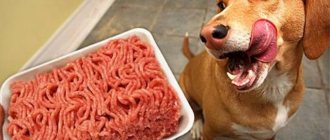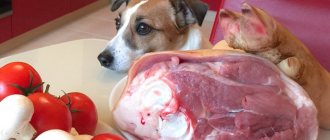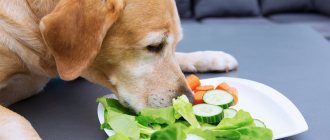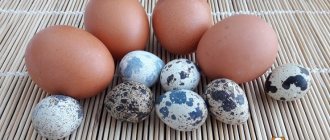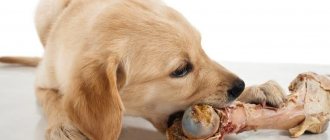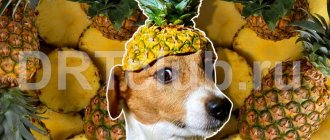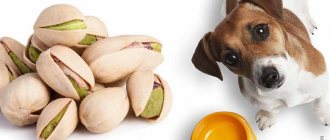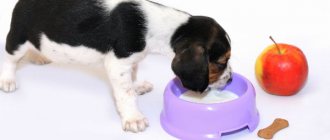The health of pets largely depends on a balanced diet. Many owners are faced with a ban on pork in their dog’s diet. This meat is considered the most high-calorie, but is susceptible to parasitism and, as a result, causes health problems. Each owner makes his own decision whether to give his dog pork or not.
- 1 Mr. Tail recommends: why dogs shouldn’t eat pork
- 2 In what form can you give pork to dogs?
- 3 Will freezing pork help?
- 4 Dangers and benefits of pork
- 5 Consequences of feeding dogs pork
- 6 Meat in the diet of dogs 6.1 Examples of diets for different dogs
Why dogs can't eat pork
Among novice dog breeders, the ban on feeding dogs pork remains popular.
Owners avoid including pork in the diet for the following reasons:
- Eating raw meat or offal can cause infection with diseases such as helmitosis, toxocariasis, rabies and Aujeszky's disease;
- The abundance of fatty foods in the diet increases the cholesterol level in the pet’s blood;
- Eating pork slows down and impairs the animal’s digestion;
- “Heavy” meat provokes intestinal volvulus.
However, painful symptoms are caused by an imbalance of proteins, fats and carbohydrates.
In fact, including fatty acids in your diet is essential for healthy coat growth, circulation and skin repair, especially during the colder months.
Pork meat should be included in your pet’s diet as one of the components, along with cereals, vegetables and dietary meats (veal, rabbit and lamb) and poultry.
In addition, the digestion of pork by the gastrointestinal tract takes up to 12 hours, therefore, in order to avoid indigestion and, as a result, intestinal volvulus, veterinarians recommend increasing the standard break between meals. You should avoid feeding pork every day and do not expose your pet to physical activity for 1.5-2 hours after eating.
If you ate a big piece
There are often cases when dogs either find lard thrown away by someone on the street, or, due to the owner’s oversight, eat it at home. If the piece eaten is large, the dog may become ill.
How do you know if you've eaten too much?
Signs of overeating fatty foods:
- bloating, seething in the gastrointestinal tract;
- may change to a lighter color of stool;
- passivity;
- cannot lie quietly in one place.
What to do?
Be sure to contact your veterinarian if signs do not change or if the condition worsens.
But you can try to cope on your own by providing first aid:
- Induce vomiting : a) pour into the mouth using a syringe a mixture of 3% hydrogen peroxide with water or saline solution (50/50), at the rate of 1 tablespoon per 3 kg. weight; b) pour in saline solution - 2 tsp. salt per 1 glass of warm water.
- Give a sorbent drug – Enterosgel (Chitosan or Enterodes). Based on an average dog, 3 times a day, 3 cm of gel, if the powder is in a bag, then 3 times a day is the norm, as for a child. It works more effectively than activated carbon.
- Smecta 2 times a day for 3-4 days .
- Arrange a fasting day on the water , and for the next week a strict diet - boiled rice, oatmeal with lean meat.
- Give medications to support the pancreas and liver : for example, Essentiale Forte and Pancreatin. The rate and duration of admission should be prescribed by a veterinarian. Typically, Pancreatin is calculated at 30 mg per 1 kg of weight, 3-4 times a day with meals.
Can dogs have boiled pork?
Eating raw pork meat to a dog often causes infection with infectious diseases and parasites.
To ensure rapid growth and weight gain, meat producers influence the hormonal levels of pigs, which results in suppression of the animals' immune system. For this reason, pigs become carriers of helminths and some infections that can be transmitted to pets when fed raw pork.
To avoid infecting your dog when feeding pork, the meat should be thoroughly cooked.
Some viruses are also resistant to heat treatment. For example, the false rabies virus transmitted by pigs can remain viable at a temperature of 70 ° C for 15 minutes. In this regard, experienced owners recommend boiling pork meat for 40 to 60 minutes, and including it boiled in the pet’s diet.
Can pig meat cause illness?
Veterinarians explain why dogs should not eat pork due to the risk of developing dangerous illnesses. Fatty foods can cause serious illnesses that are difficult to treat in the future. Some of them are difficult to quickly diagnose, which subsequently leads to the death of the pet.
Here is a list of the main pathologies:
- Aujeszky's disease, or pseudorabies, which is caused by eating raw foods contaminated with bacteria. The disease develops rapidly and often ends in death.
- Nematodosis or toxocariasis, caused by worm larvae that have entered the quadruped. Spreading quickly, helminths multiply in all internal organs. Without timely treatment, the dog dies.
- Tapeworm attacks the central nervous system and can be fatal. The pathology is rare and therefore difficult to diagnose. However, treatment started on time gives good results.
- Trichinosis, which is caused by parasites that live in raw meat. They are able to live in the body for several years, causing harm to internal organs and destroying them. If the disease is not treated, the outcome will be disastrous.
All of these ailments develop due to the consumption of contaminated food that has not been cooked. Therefore, the presence of raw kibble in the diet can be dangerous for your four-legged friend.
How to include pork heart in a dog's diet
Heart is included in dog food as a source of protein. Contrary to popular belief, pork heart, like chicken and beef, does not contain fat, as it consists entirely of muscle tissue.
Heart tissue is a rich source of minerals (potassium, magnesium) and iron necessary for healthy muscles and bones. Pork heart is easier to digest compared to beef heart and is considered more dietary. In addition, pork by-products are widely available and cheaper.
The main danger for dogs when consuming pork heart is helminths. Thorough heat treatment will help avoid infection.
When used correctly, pig heart muscle can become a complete source of animal protein and support the harmonious development of the pet during periods of intense training.
Is it possible to give a dog pork skin?
The fattest part of the carcass is the subcutaneous area. The layer of fat in the pork skin area provides thermoregulation. Fearing the development of obesity in pets, dog breeders avoid feeding their pets skin.
Pork skin
At the same time, in the natural environment, the closest relatives of domestic dogs - wolves and wild dogs - eat all parts of the carcass, including the skin. The skin is useful for maintaining healthy joints and skin of your pet. Regular consumption of pork skin as a supplement to the basic diet will help avoid the development of chondrosis and osteoporosis.
A frozen roll made from pork skin, offal and poultry would be an excellent treat for your pet.
It is possible to purchase pork skin at a low price at meat markets, but you should carefully choose the seller and first make sure that you have the necessary sanitary permits.
Features of feeding a puppy
- Small huskies need to be fed more often; complementary feeding is especially important in the first month of life.
- All of the above products for adults are suitable for feeding puppies. Meat can be consumed as early as one month of age.
- Dry food must meet not only the criteria stated above, but also be intended specifically for puppies. Due to its high vitamin content, it is not suitable for adult huskies.
- Based on reviews from veterinarians, you can choose vitamin supplements.
What do you feed your pet?
Dog shows on the zoo portal
A lot of interesting things on the RKF website
Can dogs have lard?
Pork lard is a source of triglycerides and vitamins, but is poorly absorbed by the dog’s body. Undigested product accumulates in the liver cells and leads to pet obesity. In this case, the process of deposition occurs initially on the internal organs of the animal and then affects the constitution of the dog.
In addition to damaging the liver of pets, feeding lard can cause problems with the cardiovascular and digestive systems.
Despite the fact that the animal needs fats for hair growth, feeding lard to a domestic predator is highly not recommended. It is preferable to include meat with a fat content of up to 40% in the diet.
Is heat treatment the solution?
Recently, there has been a tendency to reconsider the categorically negative attitude towards the question of whether it is possible to feed a dog pork. The value of the product is obvious, so the owner must decide for himself whether to include it in the four-legged menu. Heat treatment helps prevent parasite infestation.
Is it possible to give raw pork to dogs?
Heat-treated raw materials are not a safe product on a dog’s menu. Food will be poorly digested and become a source of dangerous bacteria and infections. In addition, from raw food you can become infected with worms that affect the internal organs of your pet. It is difficult for non-specialists to identify such an infection without additional tests, so feeding raw food can be dangerous to the health and life of your four-legged friend.
Is it possible to give dogs boiled pork?
This feeding option is considered by veterinarians to be the only acceptable one. The lean pieces are boiled, and if there are parts that are too fatty, the fat is cut off. In this case, food will not overload the liver and clog blood vessels with cholesterol. Food will be digested better if it is cut into small pieces. It is recommended to choose raw materials from piglets for nutrition.
It is recommended to give boiled pork no more than twice a week and only if the animal does not suffer from chronic obesity or has no problems with the cardiovascular system, liver, or kidneys.
An alternative is to scald finely chopped pieces of meat with boiling water before eating. This method is suitable if the owner has little time to cook.
Can dogs eat pork lung?
Pig lungs are given to dogs as a treat. The lungs are composed primarily of connective tissue and are not digested by the canine digestive system. Due to the structural features of the lung tissue, this type of by-product does not benefit the animal’s body; moreover, due to its low digestibility, the lungs often cause vomiting.
Due to difficulties in digestion, pig lungs are given to pets in limited quantities and only in combination with other protein-rich offal or with poultry or beef.
It is recommended to prepare a meat mix from boiled lungs, liver and heart and mix them with porridge for complete nutrition for the dog. Kidneys should not be added to a meat mix with lungs.
Also, you should not feed your pet this offal raw. Pig lungs are elastic, and if eaten whole the animal may choke. The lungs are given to the pet boiled or dried.
The by-product contains a wide range of useful substances to strengthen the animal's respiratory system, including:
- trace elements (sodium, magnesium, iron, potassium, phosphorus, iodine);
- vitamins (C, A and group B).
However, lung feeding should be done with caution and prior veterinary consultation for dogs susceptible to allergic reactions.
Is it possible to give a dog pork kidneys?
Kidneys are rightfully considered the most dietary treat for dogs, as they are digested better than other by-products and the fat content in kidney tissue is less than 3%. In addition, they contain a full range of essential minerals and trace elements, and are also rich in selenium and vitamins A, D and group B. The delicacy improves the process of hematopoiesis and saturates the animal’s body with amino acids.
Pig kidneys for dogs
It is noteworthy that among all types of this by-product, pork kidneys are the most useful, since they are easier to digest than beef kidneys, and are more saturated with nutrients compared to lamb and poultry kidneys.
Pork kidneys have a sharp, specific smell; for this reason, they are rarely used in cooking. When feeding dogs, the intense aroma attracts the pet and increases appetite.
The offal is given frozen, since the organ consists of 80% water - during heat treatment, the kidneys lose most of their volume and are more difficult to digest.
Myths and their refutation
There is a lot of prejudice against pork on pet menus. However, the recommendations of experienced dog breeders and veterinarians refute some of them. Some of the most common misconceptions include:
- Poor digestibility. This is not true: the product is absorbed by the body no worse than veal, duck or chicken, second only to lamb.
- Increased fat content. Indeed, most of the pig carcass contains fat. However, you can choose lean cuts to feed, such as tenderloin or shoulder. They contain several times less fat than chicken.
- Low content of vitamins and microelements. On the contrary, all parts are rich in B vitamins, zinc, magnesium, phosphorus, copper and other substances necessary to maintain good health.
- Dangerous intestinal volvulus. It is not provoked by pork, but by excessive physical activity immediately after a hearty lunch.
- High cholesterol levels. This is true, but fatty fish and even chicken eggs can cause problems with blood vessels.
You should not be afraid to offer your pet pork-based food. The main thing is to observe moderation, use only high-quality and low-fat pieces for feeding, and subject them to heat treatment. You should not refuse to buy industrial feed, which contains pork processed according to all the rules.
How to feed your dog pork
To avoid health problems for your dog and diversify his diet, you should follow a number of rules:
- Unlike other types of meat, it is not recommended to serve pork raw, only boiled for at least 45 minutes;
- Pork meat even in its raw form is considered heavy food for an animal, especially after heat treatment, during which the digestibility of the product is reduced by 40%, so it is not advisable to feed your pet pork every day;
- for feeding a dog, it is preferable to choose less fatty meat, with layers of connective tissue, as this will have a beneficial effect on intestinal function;
- to maintain the balance of BJU in the dog’s diet, pork and its by-products should be mixed with boiled vegetables, cereals, other dietary meat or dry food;
- meat should be purchased only from reliable retail chains or from a certified manufacturer to avoid transmitting diseases to your pet through food;
- It is advisable to introduce pork into a dog’s diet in the autumn-winter period, and immediately after feeding, give the dog a quiet rest and avoid physical activity for 2 hours; however, in order to avoid the development of obesity, we do not recommend completely eliminating exercise.
What type of food should I choose?
Each of the two types has its own pros and cons.
Pros of natural nutrition:
- there are no harmful additives in natural products;
- the presence of natural protein and fiber in the diet;
- the ability to independently monitor the quality of products, which cannot be controlled in the case of dry food.
Disadvantages of natural nutrition:
- it takes time to prepare food;
- To select the right balanced diet, knowledge and time are required, as well as consultation with a veterinary nutritionist;
- It is difficult to transfer a dog from natural food to dry food if the need arises.
Pros of feeding dry food:
- you don’t need to spend a lot of time choosing a menu for your dog;
- no time required for cooking;
- the food already contains the necessary vitamins and minerals;
- dry food is easier to take with you on a trip.
Disadvantages of feeding dry food:
- insufficient moisture content in dry food;
- the difficulty of choosing food that is suitable for a particular dog;
- possible content of harmful additives in the feed;
- the price of good dry food is very high;
- the inability to give the dog natural products if dry food is usually used.
It should be recalled once again that a mixed type of food is not suitable for a husky, so you need to choose from these two options.
Interesting: A dog that doesn’t bark: a description of the Congo Terrier
